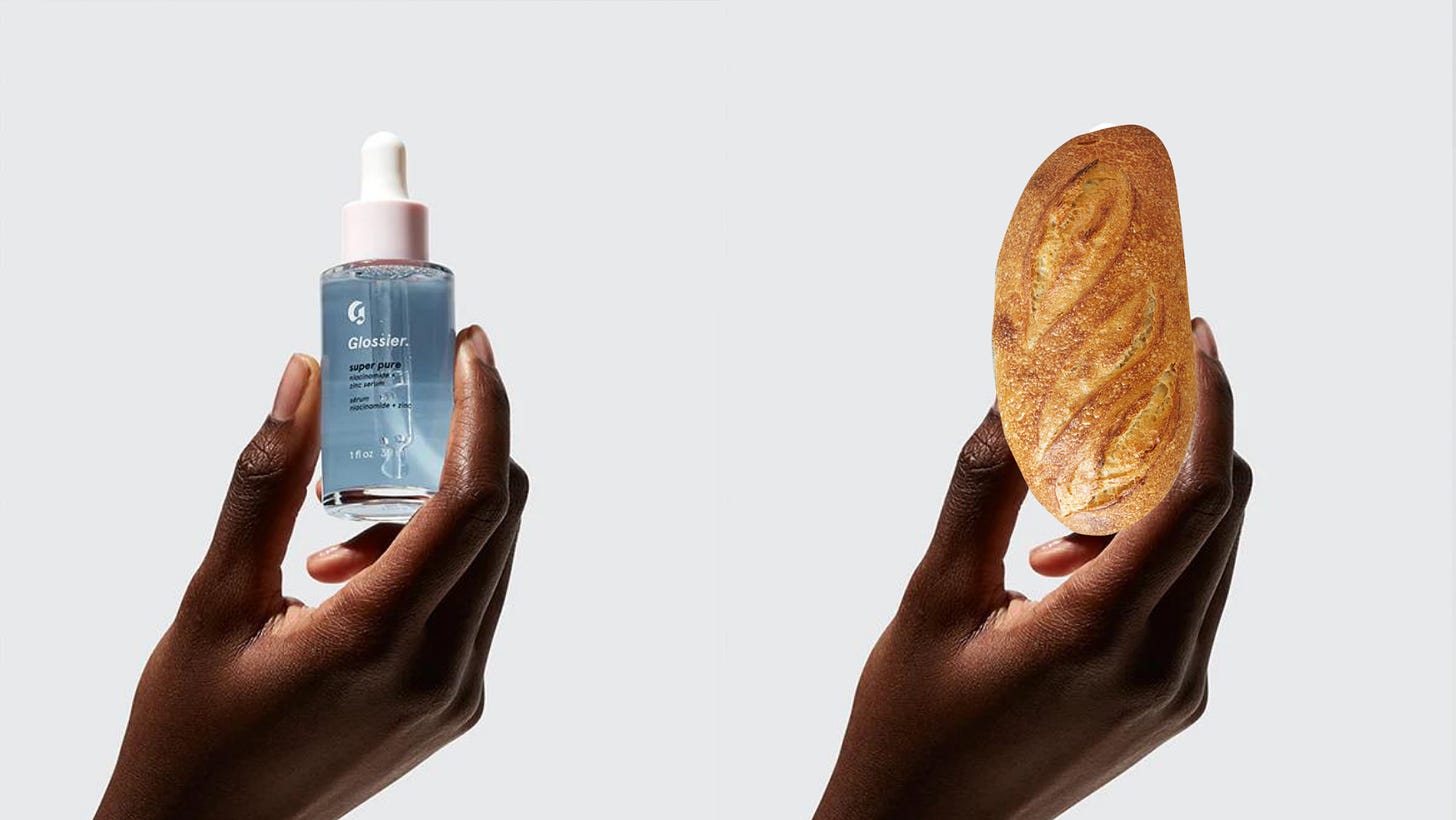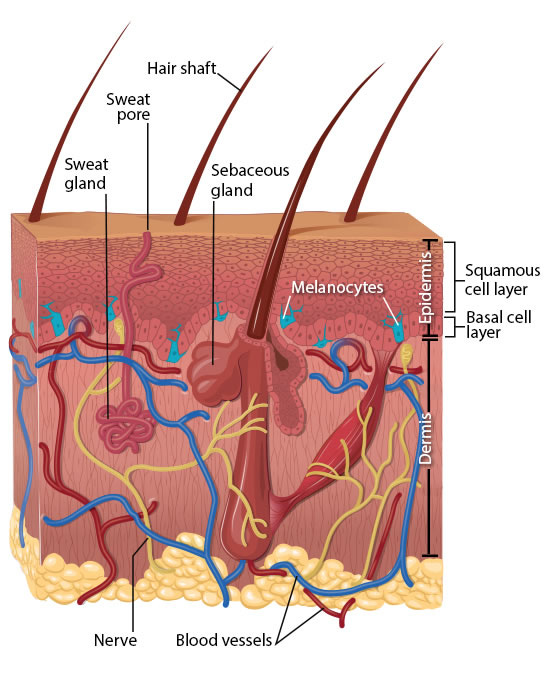This is a story about skin and serum and sourdough.
In the 1920s, the citizens of South Carolina were overwhelmed by a mysterious illness: pellagra. It started innocently enough — just a bit of a rash, red and scaling. Standard stuff. Soon, though, the rash spread across patients’ hands and faces. Its color darkened. Its scales thickened. Eventually, it would crust and crack and peel and burn in the sun, leaving butterfly-shaped lesions behind.
New symptoms emerged as pellagra progressed. Sufferers experienced diarrhea. Next came depression and, for some, full-on psychosis. At its height, the condition affected 200,000 people and killed 7,000 people per calendar year, many of whom were committed to insane asylums in their final days. Pellagra became known as “the sickness of the four D’s”: dermatitis, diarrhea, dementia, and death. (I doubt there exists a better illustration of the all-important Gut-Brain-Skin Axis than dermatitis, diarrhea, dementia, and death.)
What was the cause? Doctors originally blamed spoiled corn. Others wondered if pellagra was spread by insects. Some believed it to be the result of a yet-to-be-discovered bacterium. Joseph Goldberger, a Hungarian epidemiologist, hypothesized that pellagra was not a biological issue at all, but an economic one; that “Southerners fell ill because they were poor and ate a diet heavy on salt pork, molasses, grits, and cornmeal but woefully deficient in foods known to prevent pellagra, such as eggs, milk and butter, fresh meat, and green vegetables,” according to the South Carolina Encyclopedia.
An economic upturn in 1919 affirmed Goldberger’s theory. As income levels rose and more Carolinians could afford more fresh foods, pellagra levels fell. Results see-sawed again during the Great Depression, when food was scarce and pellagra skyrocketed.
It wasn’t until the late 1930s that researchers uncovered the root cause: a lack of vitamin B3, or niacin — but you might know it better as niacinamide, the ingredient that’s taken over the skincare industry in water-soluble serum form. “As a result, in 1939 niacin was added to bread in the US and pellagra numbers rapidly dropped,” wrote Dr. Monty Lyman in The Remarkable Life of the Skin. Ingesting niacin via fortified bread did all the things modern niacinamide serums purport to do: helped skin retain moisture, therefore making it more “plump”; reduced redness and inflammation; and healed active outbreaks and wounds — and it tended to mind and stomach symptoms, too. “It was clear that with pellagra, the skin was the harbinger of a dangerously deficient diet,” Dr. Lyman concluded.
Now, it must be said: It is a cruelty of the English language that the word “diet” can be used to describe both “eating in general, which one must do in order to live” and “limiting one’s nutrient intake in order to meet an oppressive, fat-phobic standard of beauty.”
This philological failing is very convenient for diet culture. It conflates wellbeing and restriction; a “healthy diet” (meaning, “generally eating in a way that meets the core nutrient needs of the average human being”) reads and sounds like a “healthy” “diet” (which is easily interpreted as “health equals restricting”). With almost no effort at all, weight loss companies co-opt customers’ most basic instinct — eating — to the tune of $71 billion in profits per year.
It’s also convenient for beauty culture. Within the context of a society that messages health as thinness and thinness as beauty and all three as moral imperatives, it’s all but impossible to escape the idea that consuming less will paradoxically lead to more health and more beauty. But in reality, eating to support your epidermis isn’t about eliminating anything1. It’s about eating more foods that make it possible for the skin to do its job (that is, to cover your internal organs in a protective, all-but-impenetrable layer of flesh and hair follicles and future-dust).
In this way, the restriction of diet culture enables the consumerism of beauty culture. When you reject sources of nourishment in pursuit of thinness or dominance or control, your skin may reflect it2 — and it’s easy for the beauty industry to convince you to apply the nutrients you aren’t getting from food directly to your face3.
The restriction of diet culture enables the consumerism of skincare culture.
The fatty acids in your $52 face oil? You’d get them from the “fatty” foods diet culture tells you to avoid. The antioxidants in your luxury anti-pollution cleanser? You’d get them from the fruits diet culture tells you are “too high in sugar.” (And if your initial reaction here is, “But the nutrients in foods are dispersed throughout the whole body, they don’t specifically target the skin”? Check your Beauty Culture Brain. The only reason you wouldn’t want your entire being to receive the nourishment it deserves is if you’ve been conditioned to believe it’s more important to appear nourished than to actually be nourished.)
This is not a radical concept. This is simply how having a body works. The things you ingest and digest — foods, prescription medications, etc. — get broken down into vitamins and minerals and more, which are then distributed throughout the body via your blood vessels… the blood vessels that run through your dermis… the ones that supply your basal layer… the basal layer that births fresh skin cells. (This is why “boosts blood circulation” is a big selling point for beauty brands, by the way.)
See? Your outermost organ is literally built from the inside out using material the body obtains from foods! The Omega-3s found in fish and nuts and seeds are essential for an in-tact skin barrier and thus, a high-functioning immune system.4 The protein found in chicken and ground beef burgers and eggs and cheese is essential for collagen production and thus, wound healing.5 The vitamin C found in oranges and kiwis and potatoes has more antioxidant power than your favorite anti-pollution moisturizer, and yes — as the Depression-era pellagra outbreak proved — the niacin found in avocados and anchovies and fortified grains can protect skin cells from sun damage, regulate oil production, and calm inflammatory conditions like acne and dermatitis.
What I’m saying is6: Feel free to skip the $145 niacinamide serum and eat some bread instead.
Unless you are allergic to or intolerant of a specific food or food category, duh.
This isn’t to say that all skin issues are associated with nutrient deficiency; it’s just one possibility of many. You have 35 billion skin cells, and there are billions of reasons why some of them may be experiencing surface-level symptoms (including the fact that you are a dynamic human being covered in an adaptive tissue [skin] that is meant to react to the world within and around it as an act of survival).
This isn’t to say that topical skincare products are always unnecessary. SPF is one example of this, and there are plenty of other instances where skin may benefit from topical support, too. This is just to say that other, easier, more innate, more affordable, more foundational forms of skin support (like food!) exist.
Yes, your skin barrier is part of your immune system.
Yes, collagen serves an actual purpose in the body — and it’s not “reducing wrinkles.”
What I’m also saying is: Advocating for governments to ensure that all citizens have easy, affordable access to fresh foods that meet their basic nutritional needs — no more food deserts, no more dietary guidelines informed by corporate interests, expansion of free lunch programs in schools, expansion of Supplemental Nutritional Assistance Programs — is a more effective form of “skincare” than any individual serum!!






“It is a cruelty of the English language that the word “diet” can be used to describe both “eating in general, which one must do in order to live” and “limiting one’s nutrient intake in order to meet an oppressive, fat-phobic standard of beauty.”
As someone who lives with T2D, Celiac and CSID, this jumped right out and hugged me. People watch me navigate eating and flat ask if I have an eating disorder. If we get into the story of my health, once I say that low-FODMAP and the elemental diet (a specialized medically-supervised liquid diet for people with severe digestive issues including gastroparesis, which is a symptom of my T2D) damn near killed me, I get more lectures about dieting and food restriction. Like, no one can see past wanting to be smaller BITCH I WANNA EAT WTF. I hate it here.
This is SO good. I feel like this is the narrative for so many things - especially when it comes to supplements: cut out the calories and take the supplement instead. In reality, food still proves to provide the best results for nutrient intake compared to supplements. The industry is so twisted. Thanks for sharing!